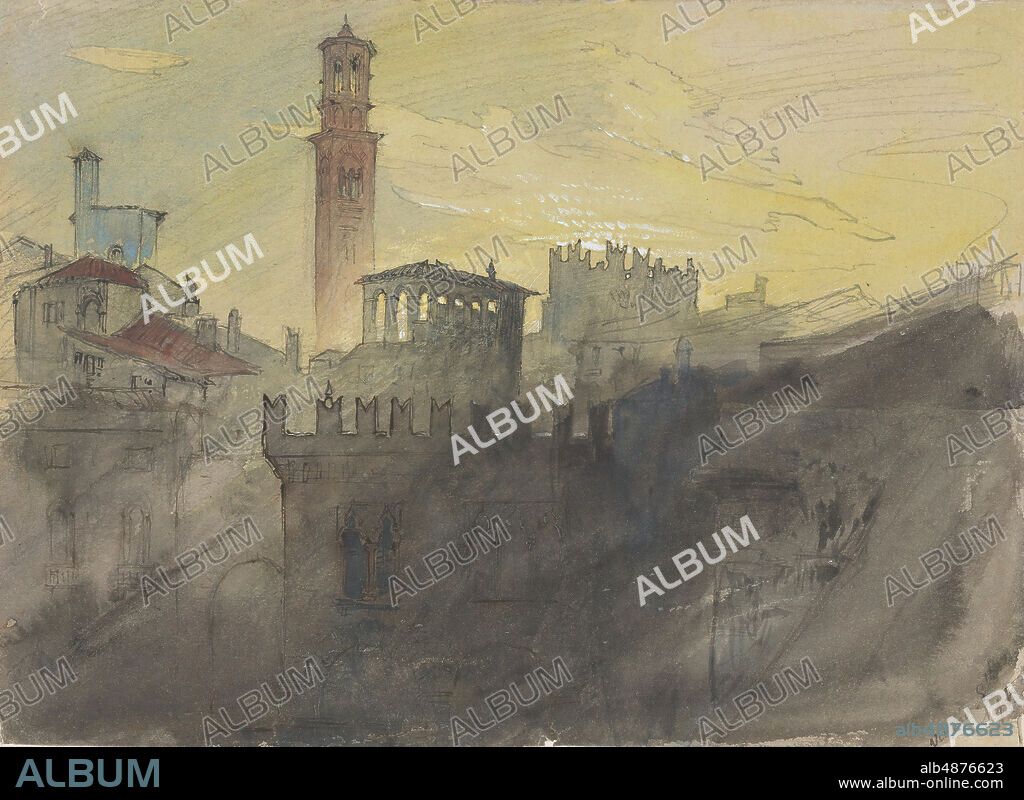alb4876623
John Ruskin, Verona at Sunset, ca. 1850, watercolor and black ink over graphite on gray wove paper, 6 3/8 in. x 9 15/16 in. (16.19 cm x 25.24 cm), One of the 102 European and American drawings and watercolors gifted to Bowdoin College in 1956 by Miss Susan Dwight Bliss, 'Verona at Sunset' came with the stipulation that it be used to strengthen the teaching potential of the school and Museum, particularly for the benefit of students in Maine. Depicting the Verona roofline at sunset in a deeply shaded style he identified as 'Turnerism' in 'The Modern Painters,' Ruskin likely created this watercolor while studying in Italy in 1851, when he completed a number of watercolors as studies for his book 'The Stones of Venice' (1851). While based in Venice, Ruskin was enamored of Verona, which he called his 'dearest place in Italy.' He admired the city for its 'perfect examples of the great twelfth-century Lombardic architecture, which was the root of all the medieval art of Italy, without which no Giottos, no Angelicos, no Raphaels would have been possible.'.

|
Ajouter à une autre Lightbox |
|
Ajouter à une autre Lightbox |



Avez-vous déjà un compte? S'identifier
Vous n'avez pas de compte ? S'inscrire
Acheter cette image.
Sélectionnez l'usage:

Légende:
Voir la traduction automatique
John Ruskin, Verona at Sunset, ca. 1850, watercolor and black ink over graphite on gray wove paper, 6 3/8 in. x 9 15/16 in. (16.19 cm x 25.24 cm), One of the 102 European and American drawings and watercolors gifted to Bowdoin College in 1956 by Miss Susan Dwight Bliss, 'Verona at Sunset' came with the stipulation that it be used to strengthen the teaching potential of the school and Museum, particularly for the benefit of students in Maine. Depicting the Verona roofline at sunset in a deeply shaded style he identified as 'Turnerism' in 'The Modern Painters,' Ruskin likely created this watercolor while studying in Italy in 1851, when he completed a number of watercolors as studies for his book 'The Stones of Venice' (1851). While based in Venice, Ruskin was enamored of Verona, which he called his 'dearest place in Italy.' He admired the city for its 'perfect examples of the great twelfth-century Lombardic architecture, which was the root of all the medieval art of Italy, without which no Giottos, no Angelicos, no Raphaels would have been possible.'
Personnalités:
Crédit:
Album / quintlox
Autorisations:
Taille de l'image:
5580 x 4068 px | 64.9 MB
Taille d'impression:
47.2 x 34.4 cm | 18.6 x 13.6 in (300 dpi)
Mots clés:
AQUARELLE • ARBRE RACINES • CITE • ECOLE • ECOLE: ROMAINE • ETUDES • ITALIE • JOHN RUSKIN • MEDECINE RACINE • MUSÉE • PEINTURE AQUARELLE • RACINE • ROMAINE, ECOLE • TECHNIQUE: AQUARELLE • VILE • VILLE


 Pinterest
Pinterest Twitter
Twitter Facebook
Facebook Copier le lien
Copier le lien Email
Email
